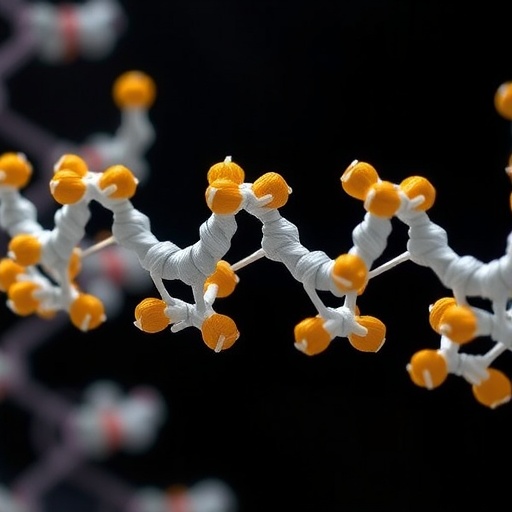Researchers at the University of Basel have achieved a significant breakthrough in the field of catalytic chemistry by ingeniously repurposing a natural enzyme to catalyze a complex and challenging chemical reaction with unrivaled precision. This novel approach combines the sophistication of enzymatic catalysis with the emerging technique of metal hydride hydrogen atom transfer (MHAT), paving the way for the efficient production of three-dimensional molecules with controlled stereochemistry. Such an advancement holds enormous potential for the pharmaceutical industry and the manufacturing of fine chemicals, promising more sustainable, precise, and cost-effective synthetic pathways.
Catalysts have long been at the heart of chemical innovation, acting as indispensable agents that accelerate reactions under mild conditions, reduce energy consumption, and minimize waste generation. Their central role is especially pronounced when synthesizing complex molecules, where controlling the speed, selectivity, and outcome of reactions directly impacts the efficiency and environmental footprint of chemical manufacturing. Over the decades, chemists have relentlessly pursued catalyst designs that can meet the stringent requirements of modern synthetic processes—demanding specificity, sustainability, and scalability.
Enzymes, nature’s highly evolved catalysts, have emerged as exceptional candidates in this quest due to their unmatched selectivity and biocompatibility. These protein-based catalysts orchestrate countless biochemical reactions with remarkable speed and precision, often under ambient conditions that are challenging to replicate synthetically. However, harnessing enzymes for non-natural or particularly demanding chemical transformations, such as asymmetric organic synthesis involving metal-mediated pathways, has remained a formidable challenge.
.adsslot_SFqhCRObBT{ width:728px !important; height:90px !important; }
@media (max-width:1199px) { .adsslot_SFqhCRObBT{ width:468px !important; height:60px !important; } }
@media (max-width:767px) { .adsslot_SFqhCRObBT{ width:320px !important; height:50px !important; } }
ADVERTISEMENT
The metal hydride hydrogen atom transfer (MHAT) reaction represents a fascinating and powerful catalytic method recently developed to efficiently construct complex molecular architectures. In this reaction, a metal hydride species—comprising a metal atom bonded to a hydrogen atom—effectively transfers the hydrogen atom to an unsaturated carbon double bond within an organic substrate. This transfer generates a highly reactive intermediate that subsequently undergoes bond formation to sculpt intricate molecular frameworks. MHAT’s capability to transform planar, two-dimensional molecules into stereochemically rich three-dimensional constructs makes it a transformative tool in synthetic chemistry.
Despite MHAT’s remarkable utility, achieving precise stereochemical control in these reactions remains an enduring dilemma. The issue lies in fabricating molecules with a definitive “handedness” or chirality—mirror-image structures that, while chemically identical, exhibit distinct three-dimensional arrangements. This differentiation is not merely academic; in drug development, for instance, one enantiomer (handed form) of a molecule can deliver therapeutic benefits, whereas its mirror counterpart may be inert or even harmful. Therefore, catalysts capable of directing MHAT reactions to yield exclusive enantiomers are of immense scientific and industrial value.
Addressing this intricate challenge, the University of Basel team leveraged the inherent chiral environment of a haemoprotein—a class of enzymes known for their metal-binding capabilities and biological versatility. By ingeniously reengineering the catalytic site of this enzyme, they enabled it to facilitate MHAT reactions with outstanding enantioselectivity. The unique protein scaffold not only stabilizes reactive intermediates but also enforces a stringent three-dimensional spatial arrangement, resulting in a product ratio with up to 98% dominance of a single enantiomer. Such stereocontrol is unprecedented in the context of MHAT chemistry and represents a milestone in enzyme engineering.
The implications of this research extend well beyond proving a concept. Integrating enzymatic catalysis with MHAT opens a new frontier in green chemistry by potentially reducing reliance on harsh chemical reagents and solvents, lowering energy input, and diminishing toxic by-products. The ability to selectively produce single-handed complex molecules can revolutionize the synthesis of pharmaceuticals, agrochemicals, and other value-added fine chemicals, addressing both sustainability and efficiency imperatives facing the chemical industry.
At the same time, the researchers recognize that the highly specialized nature of their engineered enzyme presents dual challenges. While its specificity ensures remarkable selectivity for a given substrate, it also means that alterations to starting materials may necessitate further enzyme modifications to maintain catalytic performance. This specificity, therefore, requires dynamic and iterative protein engineering strategies to broaden substrate scope without compromising efficiency.
Moreover, the formation of metal hydride intermediates within a biological framework currently depends on steps that could be optimized to enhance sustainability. Developing more environmentally benign methods to generate these reactive species will be a critical focus of future work, further aligning enzymatic MHAT catalysis with the principles of green chemistry.
The study represents a confluence of disciplines, merging insights from molecular biology, inorganic chemistry, and catalysis to transcend traditional synthetic limitations. It highlights the growing role of protein engineering in crafting bespoke catalysts capable of performing complex transformations, underlining the transformative potential of molecular systems engineering as a paradigm for chemical innovation.
The findings, recently published in the prestigious journal Nature, are the product of collaborative efforts led by Professor Thomas R. Ward and his team. Their pioneering work illustrates not only the power of enzyme repurposing but also charts a path toward more precise and sustainable manufacture of chiral molecules—cornerstones of countless therapeutic and industrial applications.
With this breakthrough, the boundaries of catalytic science are expanding, heralding an era where nature’s catalysts are tailored to meet the synthetic demands of humanity. As researchers continue to refine enzyme scaffolds for even broader reaction types and substrate classes, it becomes increasingly feasible to envisage a future where chemical synthesis mirrors the sophistication and efficiency of biological processes.
Subject of Research: Repurposing haemoproteins to catalyze asymmetric metal hydride hydrogen atom transfer reactions for stereoselective synthesis of complex molecules.
Article Title: Repurposing haemoproteins for asymmetric metal-catalysed H atom transfer
News Publication Date: 30-Jul-2025
Web References: DOI: 10.1038/s41586-025-09308-0
Image Credits: University of Basel, Xiang Zhang
Keywords
Enzyme engineering, metal hydride hydrogen atom transfer, asymmetric catalysis, stereoselectivity, haemoprotein, green chemistry, molecular synthesis, chiral molecules, catalytic specificity, pharmaceutical synthesis, molecular systems engineering
Tags: advancements in catalyst designbiocompatible catalystscatalytic chemistry breakthroughscomplex molecule synthesiscontrolled stereochemistry in chemistryengineered enzyme applicationsenvironmentally friendly synthetic pathwaysenzymatic catalysis in industryfine chemicals productionmetal hydride hydrogen atom transferprecision in chemical reactionssustainable pharmaceutical manufacturing





